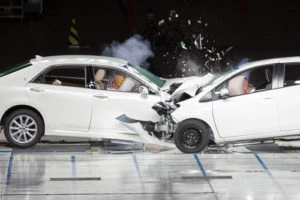
Every driver has a responsibility to exercise reasonable care to all other drivers on the road. Liability in a head-on collision is determined by identifying which driver neglected their responsibility to provide other road users with reasonable care. Frequently, this negligence takes the form of a traffic law violation, such as an illegal lane change.
After a head-on collision, the lawyer who represents you, the at-fault party’s representative, and the insurance company may all work together to assign negligence, fault, and financial liability. To determine fault when two cars collide head-on, each party may rely on:
- Crash reports
- Witness statements
- Accident scene investigations
- Medical records
- Photo and video evidence
Collecting evidence, interviewing witnesses, and conducting depositions might help establish fault for the accident. Your legal team can handle these responsibilities for you. They can also help you understand how the determination of liability in your case may affect your potential right to financial compensation.
How Head-On Collisions Are Investigated
The initial investigation into a head-on collision typically starts with the police officer who responds to the scene. He may photograph the accident scene and note any apparent causes or contributing factors that may have led to the accident. He will also collect driver, vehicle, and insurance information from each involved driver.
The responding officer will record their findings in an official crash report. A crash report is important because it can prevent the at-fault driver from embellishing the details or damage of the accident. It may also help establish the cause of the accident and help determine financial liability.
The Crash Report
Ohio Revised Code § 5502.11 mandates filing a crash report if there were injuries, fatalities, or more than $1,000 in damages. The crash report generated after a car accident might provide key evidence in proving liability. Your crash report may contain a wealth of information that helps point to the cause of the accident, including:
- The direction of travel of each involved vehicle
- Traffic violations noted and ticketed at the scene
- Police-generated photos and videos of the scene
- Witness statements and observations
- Driver distractions or alcohol involvement
Do not overlook the importance of your crash report. It can also help your legal team determine the filing deadline of your potential lawsuit and ensure compliance with the statute of limitations. Obtain a complete copy as soon as it becomes available and provide one to your legal team.
Witness Statements
Your crash report may contain statements and contact information from witnesses who saw the collision. Witnesses might come forward on their own or respond to requests and appeals in the aftermath of the collision. Witness statements are important because they may offer an objective and unbiased account of the accident.
The police who respond to the accident scene may question witnesses and record their contact information. If possible, obtain contact information from witnesses on your own to be sure no witness is overlooked.
Photo and Video Evidence
Photos and videos can tell the visual story of your accident and help identify its causes. Like witnesses, images and video are objective and unbiased. If your injuries prevented you from doing so, a witness or bystander might have taken photos of:
- Your car from a variety of angles
- The at-fault driver’s vehicle
- The accident scene
The investigating officer might also have taken photos. If possible, local law enforcement or your lawyer may search for any available video footage of the accident. That might include dash camera footage, witness smartphone footage, and residential or commercial surveillance footage.
We Will Be
There To Help
You All The Way
Medical Records
The National Highway Traffic Safety Administration (NHTSA) defines an accident where two cars collide at their front ends while driving in opposite directions as a head-on collision. Any type of car accident has the potential for danger, but a head-on collision might increase your risk of serious injuries.
The medical records generated after an accident can indicate the cause and extent of your injuries. They can also help by establishing the current and future costs of your injuries and their required treatments. This information may help your lawyer prove the value of your potential compensation lawsuit.
Assign Financial Liability to the At-Fault Driver
To find out how liability may be determined in your head-on collision, call the Fitch Law Firm LLC today at (614) 545-3930. Our client support team will provide you with a free case review. If you qualify, a car accident lawyer from our firm can build you a complete case file with evidence of the responsible party’s liability.
The Fitch Law Firm LLC represents clients in and around Columbus.
